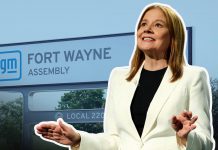With many businesses temporarily closing their doors in an effort to practice “social distancing” during the Coronavirus outbreak, many dealerships remain uncertain about what steps they need to take next. Here to give us an update on the current state of the whole business and the used-car market during these unprecedented times, is Jonathan Banks, Vice President and General Manager for Vehicle Valuations at J.D. Power.
VIDEO TRANSCRIPT:
Jim Fitzpatrick: Hi everyone. Jim Fitzpatrick with CBT News. Thanks so much for joining us today. Today we’re happy to have with us Mr. Jonathan Banks, who’s vice president and general manager for vehicle valuations at J.D. Power. Thanks so much for joining us today, Jonathan.
Jonathan Banks: Thanks for having me, Jim. Glad to be here.
Jim Fitzpatrick: Yeah, you must be a busy guy right now with all that’s going on in the industry and I’m sure dealers are out there, very concerned about the valuation of used cars as it relates to their inventory and then also the inventory they’ve sent to auctions and the inventory that they want to buy. Let’s kind of jump right in. Talk to us a little bit about how the year was going prior to this coronavirus situation.
Jonathan Banks: Well, just a few weeks ago, Jim, we are at the NADA convention talking about this. It’s the golden age of used vehicles. Used vehicle prices in 2019 went up 1% compared to 18 so it was a really good year. While used supply was going up, we are expecting worst-case scenario for 2020 for used prices to be flat. The most likely scenario was somewhere up by a half to 1% in prices. And we were expecting that to be driven by the strong underlying demand that we had been witnessing for the past two years. We expected a continuation of that and January, February and even the first week of March, were showing a lot of strength. First week of March, prices were up 2% compared to February.
Jim Fitzpatrick: Wow.
Jonathan Banks: This is a brand new phenomenon that we have yet to really witness the negative effects, but we know they’re coming and we’re working really hard at J.D. Power to try to figure out exactly what we can expect under some different scenarios.
Jim Fitzpatrick: Yeah. Any advice to dealers that are sitting on inventory right now? We’ve gotten a number of emails and text messages from dealers that say, “Hey, have some people on the show that can tell us what to look out for and where should we be?” Should we be, one dealer said, “I’m buying all the inventory that I can get my hands on because I sense that when this thing is over,” in his estimation was six weeks, that there’s going to be this pent up demand out there if you will, in the marketplace for product. And he wanted to be sitting in a good spot. But we’ve had other people that said, “No, no, I’m holding. I’m bringing in the reins and I’m not buying anything right now.”
Jonathan Banks: Yeah, that’s a tough question to answer. It’s like, what’s your risk tolerance? It’s like jumping into the stock market right now. Do you feel comfortable getting some deals? We think that the wholesale prices should show some deals just because of the uncertainty. That’s something to consider. I think one thing that dealers should really be looking at, is there a floor plan expense for used? If they can get some really good interest rates and keep the cost down low for holding their inventory, I would be a little more pessimistic on six weeks holding. You look at China and they’re just kind of moving back to a normal state as it pertains to a retail buying process for automobiles. Figure that that was around three months. I think that’s the general consensus is we’ll be back to a normal in July.
Jonathan Banks: But that all depends on, how we as a community and meaning a community as a community of the United States population, we do to try to help control this thing. I think we will see pent up demand if we can keep the virus under control. And really I think the big factor, especially for the used market is if the government will step in and offer some support for a lot of the people whose jobs have just basically shut down. The plug was pulled immediately on many workers in a big huge sector of our industry and that’s entertainment and restaurants and a lot of that discretionary spending that just goes away.
Jonathan Banks: If we can ride that through, I think we’ll see that pent up demand come back because the used market was so strong, all the underlying factors are there. Interest rates are even going to be better when we come out of this. It’s just a matter of the people that are going to be impacted would be the used buyers and they just need to know that they’re going to be able to ride this through, until they start working again. I think that’s a huge factor for the used market.
Jim Fitzpatrick: Yeah. And used sales were before all of this corona talk and this coronavirus that’s hit us pretty hard, it looked like used sales were trending up over new car sales, for 2020.
Jonathan Banks: Absolutely. You saw it at the franchise dealers according to our, the J.D. Power pin data, the used to new ratio, which means how many used you sell to new, for franchise dealers went over one. Franchise dealers were selling more than one use vehicle per new vehicle, which we’ve seen an upward trend on that but not to that extent. I think that was the February data. And then you would have all these other entities now getting involved in selling used so demand used was stronger than we have ever seen and prices were really for both in the retail market and the wholesale market so dealers were paying a lot. That’s why I say if we see a downward movement in price, it could be an opportunity depending on your risk tolerance and your holding costs. But I would expect that to come right back. Like I said, it all depends on how we ride this through because a lot of it will have to do with how comfortable consumers feel in buying a large purchase like an automobile.
Jim Fitzpatrick: Right, right. Yeah for sure. Spoken a lot about affordability here at CBT News because it’s still at the forefront of every dealer’s mind right now in terms of 37, $38,000 for the average price of a vehicle, a new vehicle, I should say. Used vehicles are looking that much more appealing to consumers that visit today’s showrooms in lots, right?
Jonathan Banks: That’s right. Affordability continues to be a challenge on the new side, which is great for the profitability of the manufacturers and the dealers but not so great for the consumers but fantastic for the used market. And that was really one of the factors that we were looking at when we talked about that golden age of used vehicles. That affordability of new really drives so many consumers to the used market. And we were seeing a huge increase in buyers, the younger demographics, who are buying used and not only buying used, they were actually even buying cars, which conveys likely affordability. They may have a preference change too, reacting to, I don’t want to own a SUV like my mom and dad. But for sure affordability’s a factor.
Jonathan Banks: That may be impacted as if this virus becomes incredibly disruptive. You would expect that to come into play in that the manufacturers may resort to more high discounting. But based on what we’ve seen, some of the patterns of the OEMs, we’re likely going to see production cuts. I would expect that affordability issue to perpetuate, even if as long as the virus stays within, as long as we control it within a reasonable amount of time, which ultimately will keep used demand up.
Jim Fitzpatrick: Right, right. Do you think if this goes on for the next couple of months and obviously the president is talking about as late as August or September, that we’ll see a dip in credit scores, thus bringing on the secondary market as well?
Jonathan Banks: Yeah. Another great point. I think in all types of recessionary periods, we see that kind of phenomenon. If the market does act as it usually does in recession, you’re going to see the used market remain really strong, which is a positive for the dealers. Remember the beauty of it is, is now the dealers are prepared to capitalize on this. Their infrastructures are already set up to really capitalize on the used opportunity, which if you go back to prior recessions, I would say that our infrastructure wasn’t as strong. That’s a really good point because the fact of the matter is replacement demand won’t go away regardless of a recession or not. People need to buy, people need to replace their cars, they’re going to come back no matter what, as long as they still have a job. And I hate to joke about that.
Jonathan Banks: I hope today’s speech seemed to convey that the government’s going to step in, which I think is appropriate in this case for a lot of people that will lose their income. But ultimately, vehicles that are still really old on the road, replacement demand will be there, the infrastructure’s there to sell used. I think the bounce back for used is going to be a lot quicker than new. Just like we saw in the great recession, the bounce back from new was much quicker a bounce back for used was much quicker than new. Of course new followed, really, really strong after that. And it’s kind of hard to compare because that’s more of a really dramatic U, not dramatic but a longer U shaped recovery after the recession where this one I hope it’s a V shaped recovery where things just pop right back.
Jim Fitzpatrick: Yeah boy that’s for sure. And I think dealers are out there wondering where this is going to take them. They’re looking out on their lots right now. However, I will say that a couple of the dealers that I spoke to this morning said that they have not seen yet a dip in their business year over year sales for this last weekend. They were doing pretty good. Maybe this hasn’t hit us that hard yet in the industry. It was a shocker to me, but it’s not the first time I’ve been shocked. Have you seen any of that. Where there hasn’t been much of a much of a hit yet.
Jonathan Banks: Oh yeah. Like I said earlier, first week of March, prices were up another 2% and we didn’t see any impact to sales. Now what we’re looking forward to, we get some data today that we’re processing that will show the activity in the wholesale market. We’re going to be looking very closely at that to see if we see any declining volume, which would mean most sales or decline in prices on the wholesale market. We’ll have a lot more to talk about as we continue to observe this. In fact, J.D. Power is going to start putting out a weekly update for both new and used. Talk about volume and price to kind of keep everyone informed, utilizing a lot of the data that usually we kind of keep proprietary, to help inform the industry. To kind of keep in touch with what’s going on.
Jim Fitzpatrick: Oh, that’s great. That’s great. And then how will people get that information through email?
Jonathan Banks: Yeah, I think, let’s see, you could go to either our website and nada.com/b2b and just go to the contact us or jdpower.com.
Jim Fitzpatrick: Sure. We’ll place a link on how to get it right underneath this article as well for viewers that are watching us right now. But otherwise, as they say, other than what happened, Mrs. Lincoln, how’d you like the play? Other than this situation that we’re in, it seemed to be a pretty good year. And from what all the people that I’m speaking to, they feel as though if we can just contain this to just a couple of months, maybe a few months, it won’t be too much of a hit and we’ll be able to snap back in a big way. Would you agree with that?
Jonathan Banks: Yeah. And that that seems to be the consensus and our government seems very serious about taking the steps to mitigate the spread and also mitigate the economic impact. I think we’re going to see some unprecedented moves by our government and by businesses too. It looks like from a lending standpoint there’s going to be some flexibility on how they treat customers that might have some hardships with payments and things like that. I’m optimistic and then we can start talking about back to the golden age of used again where we are telling dealers, get inventory, make sure your inventory is a good diversified portfolio to align with the different demographic groups that are coming in. Really work on your customer experience that aligns it more with some of the digital retailing trends that we’ve seen. And that’s the more exciting longterm stuff that I think we’ll all come back and really push us back to being in a really healthy environment when we get through this. Our industry has done a great job on utilizing data and infrastructure to keep the used market and the new market for that matter, really healthy.
Jim Fitzpatrick: Yeah, I agree. I agree. We’ve been through worse, I think, and I shouldn’t say that. Maybe it’s still going to get worse, but we’ve been through some pretty tough times, challenging times in the auto industry and we always seem to get out of it in a good way. Jonathan Banks, VP and general manager for vehicle valuations at J.D. Power. I want to thank you so much for taking the time out of your very busy schedule right now. Thanks so much. Love to have you back on CBT for an update.
Jonathan Banks: Thanks Jim. Great talking with you and take care of yourself.
Jim Fitzpatrick: Take care. Bye bye.








